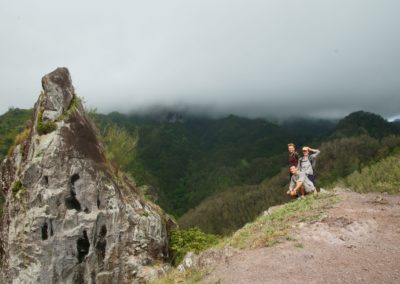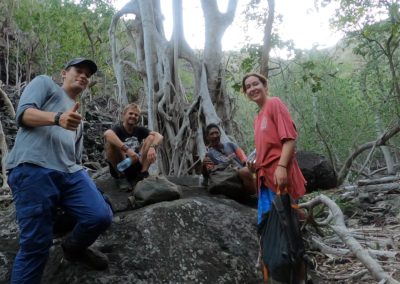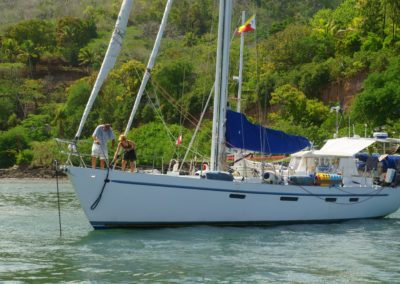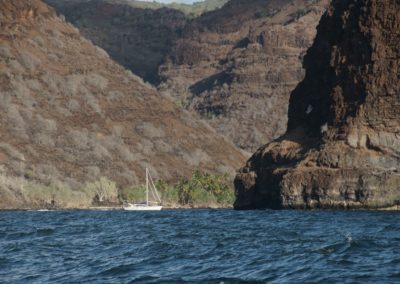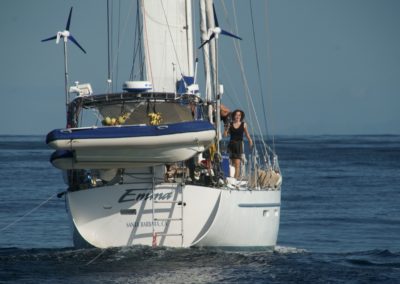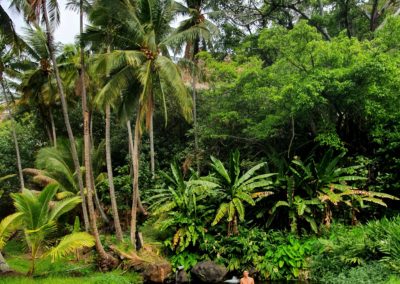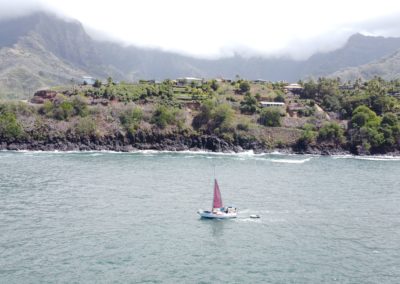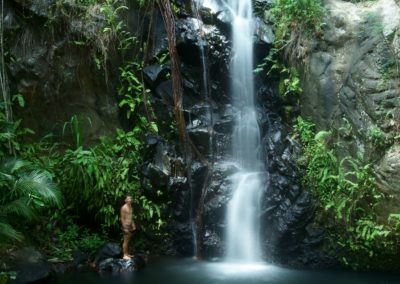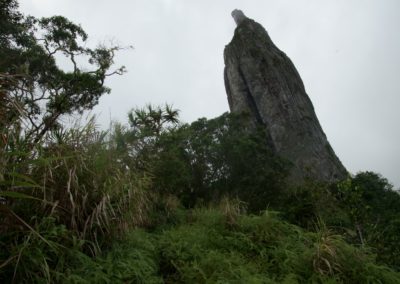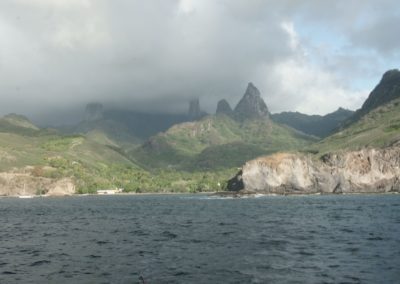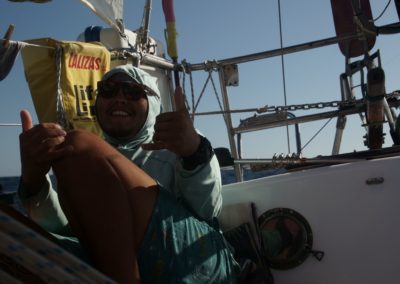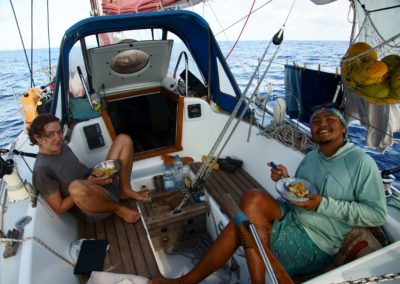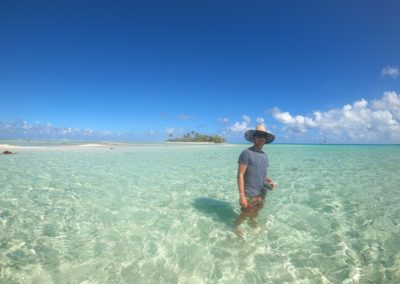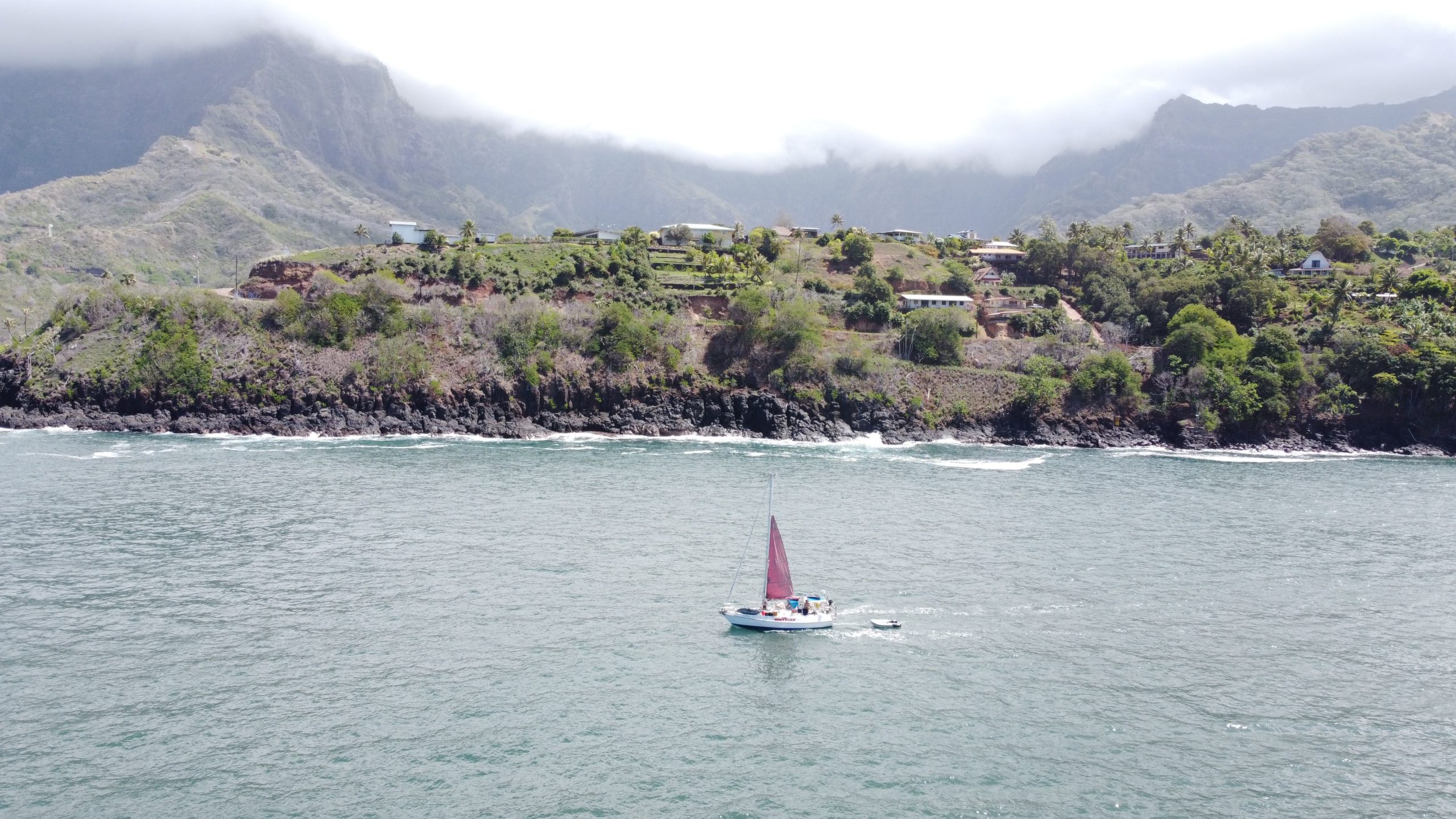
We stayed in the main anchorage of Hiva Oa for five days. The place not far from the village of Atuona was convenient for us to clear the boat and to get fresh vegetables and other small things in the supermarket.
Walking through Atuona, I met a couple of kids preparing for a surf session with their instructor. I’ve been lugging around my old surfboard since the beginning of the trip. It’s lashed to the bow most of the time and actually too small for my weight and abilities. Here and there I found a few waves to ride, but I never really went into it.
As the kids made their way into the water, I asked their instructor for a few tips: „What tide is best for the waves?“. „Any special currents?“, and „are you coming back here tomorrow afternoon? „. – I probably wouldn’t have gone surfing alone, but since the surf instructor was really nice, he immediately offered me to jump in the water with his guys and just to take a board from the school!
The kids were already surfing really well; for me it was really difficult to catch a wave at all. Nevertheless, we had a lot of fun! „Allez Paul, Allez Paul!”, they screamed in my direction; only to burst out laughing when I was thrown off the board by the breaking waves.
Also, In the bay of Atuona we met a few familiar faces again: After their disaster at sea, BLUE BERYLL made landfall in the bay and also Gretje and Niels from BLACK MOON had their boat in the boatyard there by this time.
On Sunday EMMA came sailing into the bay. We had met Kurt, Adrian and the rest of the crew for the first time on Fatu Hiva and have spent a few evenings together. EMMA is a 62 foot aluminum yacht that is also on her way to sail around the world.
Emma (my Emma), was invited to sail with them for a few months at some point. So we thought it would be cool if she could sail on the other boat for a few days to get the experience. It is quite a difference to sail on a nine-meter WASA or a 20 meter aluminum yacht!
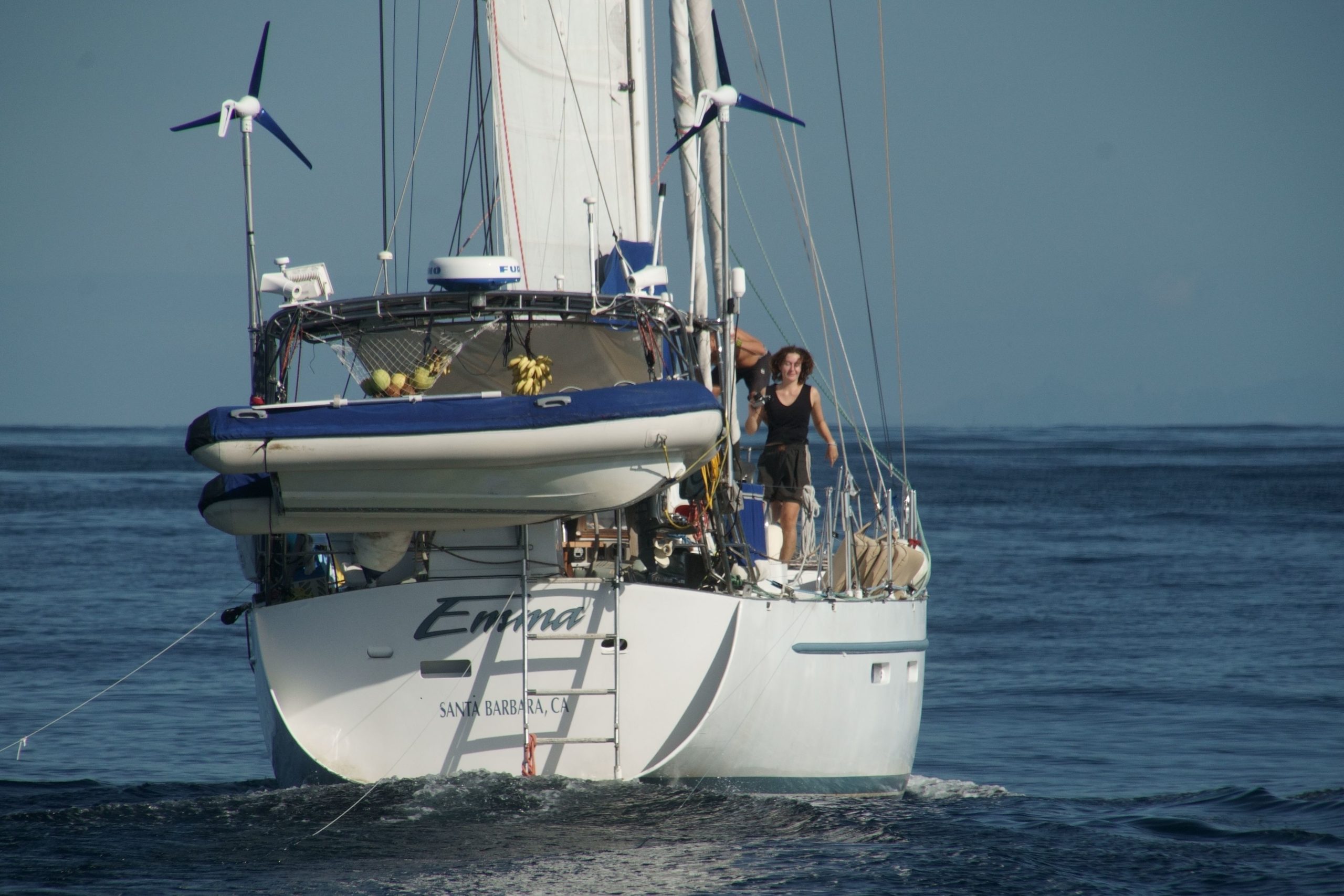
Our first destination was a small bay in the northwest of Hiva Oa: Hanamenu – a little paradise! Three people normally live in the small village. The valley is cultivated. Coconut palms and mango trees, grapefruits and lemons grow everywhere. A spring comes directly from the mountain and fills a small natural pool with crystal clear, cool water.
No sooner said than done! For the next two weeks, Emma stayed on EMMA and I sailed a few miles singlehanded on my WASA. Actually, we stayed together as a small „fleet“, which is called „buddyboating“ in sailing jargon.
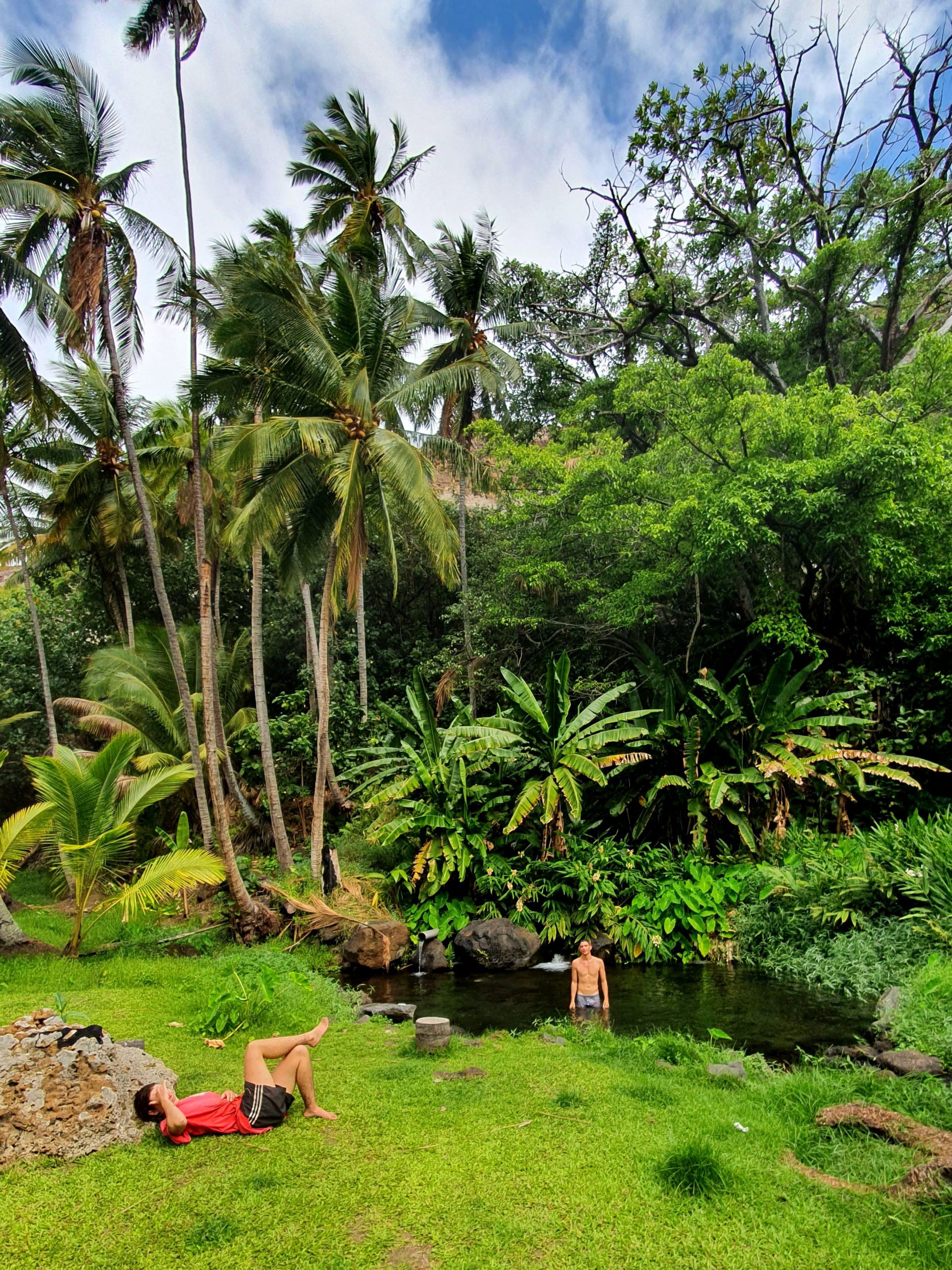
On their exploration trip, Emma and Adrian met Eugin. He lives there for a few years and invited us to join him on a goat hunt the next morning. As I had never been on a hunt before, I was immediately on fire!
At five o’clock in the morning we all met in Eugin’s garden. Adrian, Emma, Kurt and me. We had a quick coffee and started the ascent by almost running through a dry riverbed. After three hours of strenuous marsh, suddenly came the sign to stop. – Eugin had heard a snort! We waited. Eugin crept around a large rock and shortly thereafter two shots crashed into the silent valley.
On the spot, Eugin showed us how to properly dissect the goat and cut it into transport-sized pieces so that they could be transported back to the house in backpacks he had brought with us.
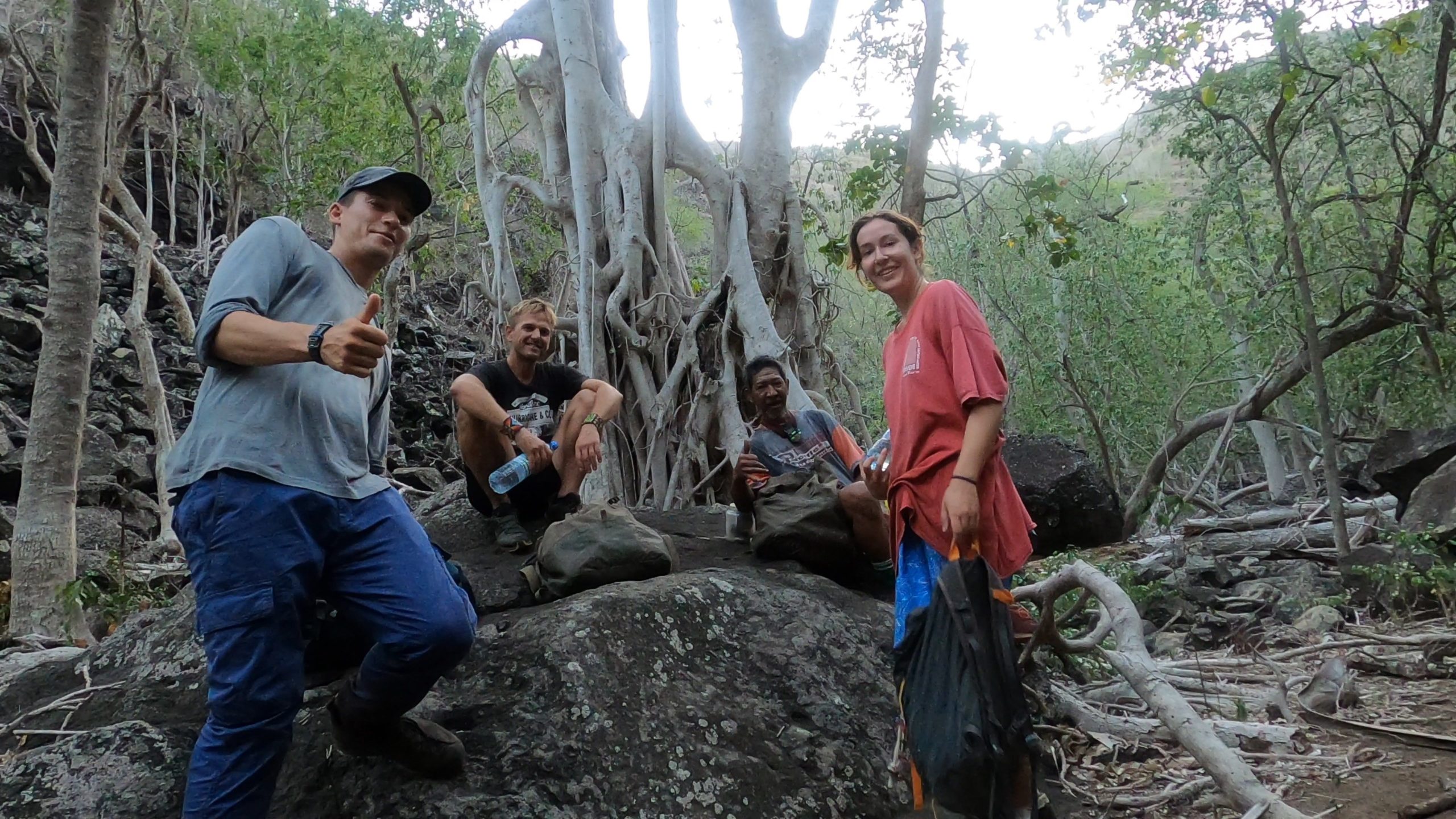
The trip was exhausting! After more than six hours we were back and immediately started to make a fire. We froze some of the meat, cooked the other for an hour, and then grilled it. It tasted fantastic! – The meat was tender, and Eugin’s homemade marinade was a hit!
We stayed another night, but then hoisted the sails the next morning and set off on the 60 nautical mile journey to the next island, Ua Pou. While EMMA covered the distance with engine in just nine hours, I needed more than 14 due to the lack of wind and small engine.
Ua Pou is just half the size of Hiva Oa. But the „skyline“ of the island is much more attractive. Three stone pillars rise almost vertically from the hilly landscape. These pillars are remnants of the island’s formation history. The volcanic craters have eroded away over the millennia. What has remained standing is the interior; the magma that hardened when it was still in the outlet of the vulcano.
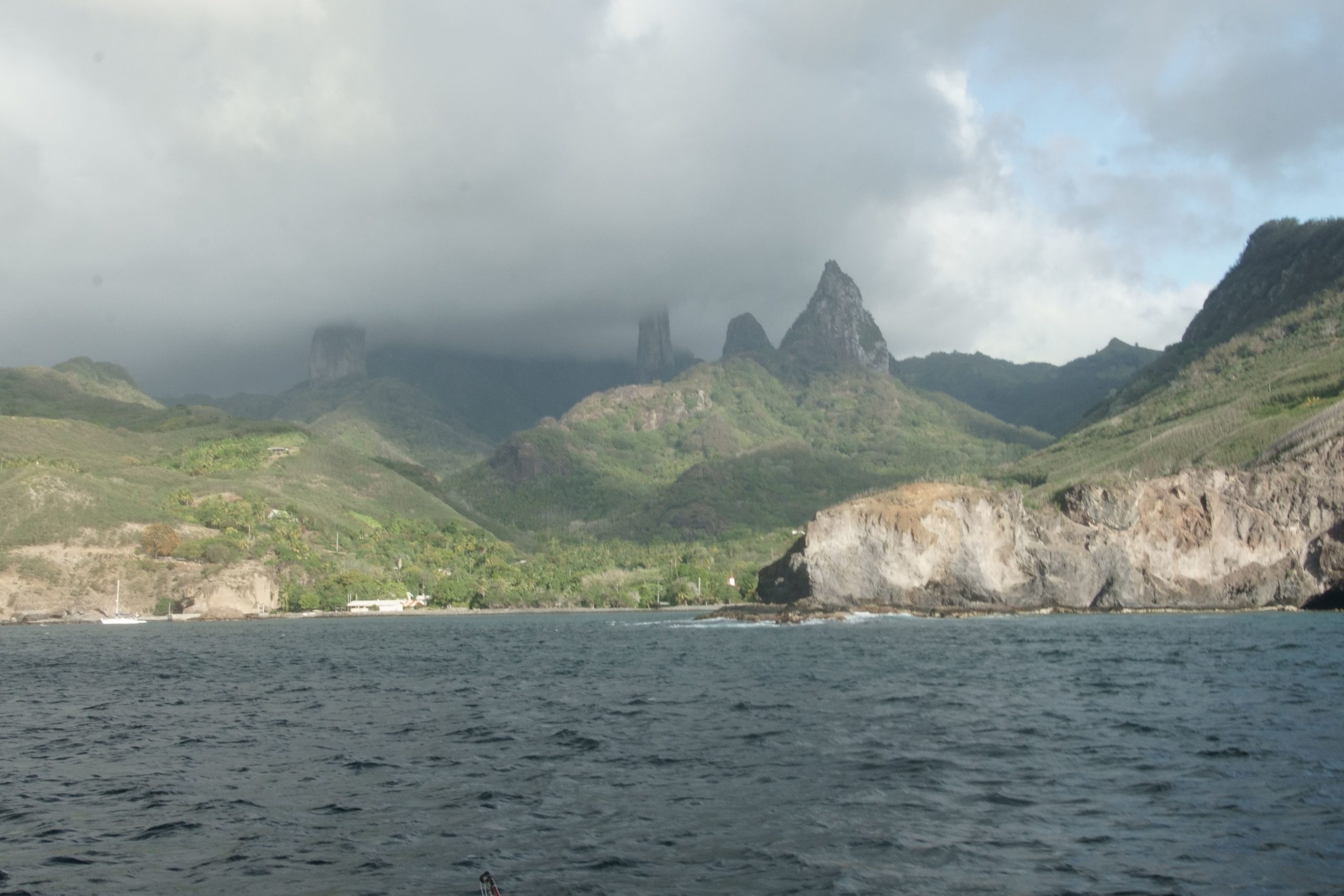
I did two hikes with Adrian. One long one, 13 km across the island and another on a circular route around these columns. The idea of having the last remains of a lava spewing giant in front of me was mind blowing!
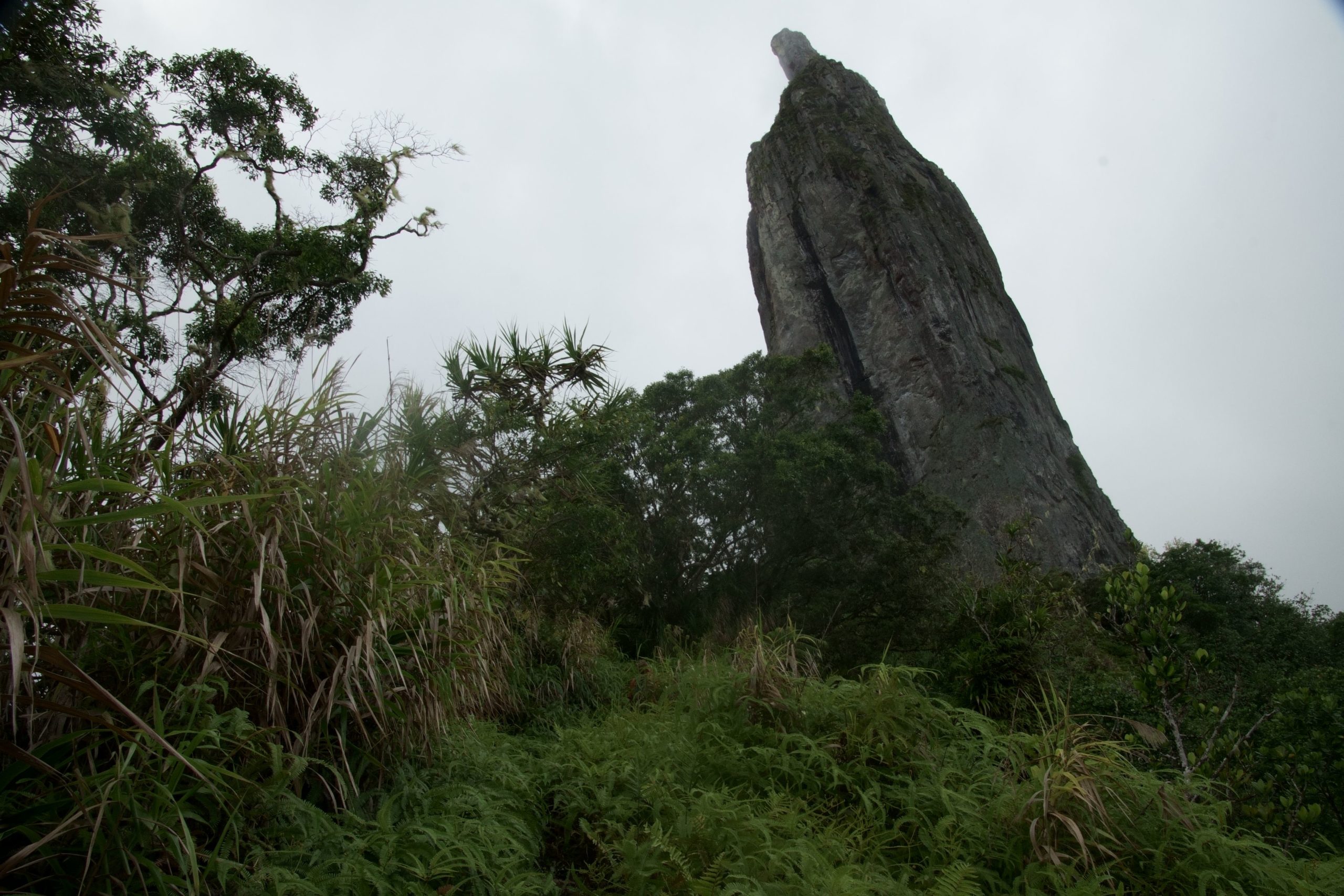
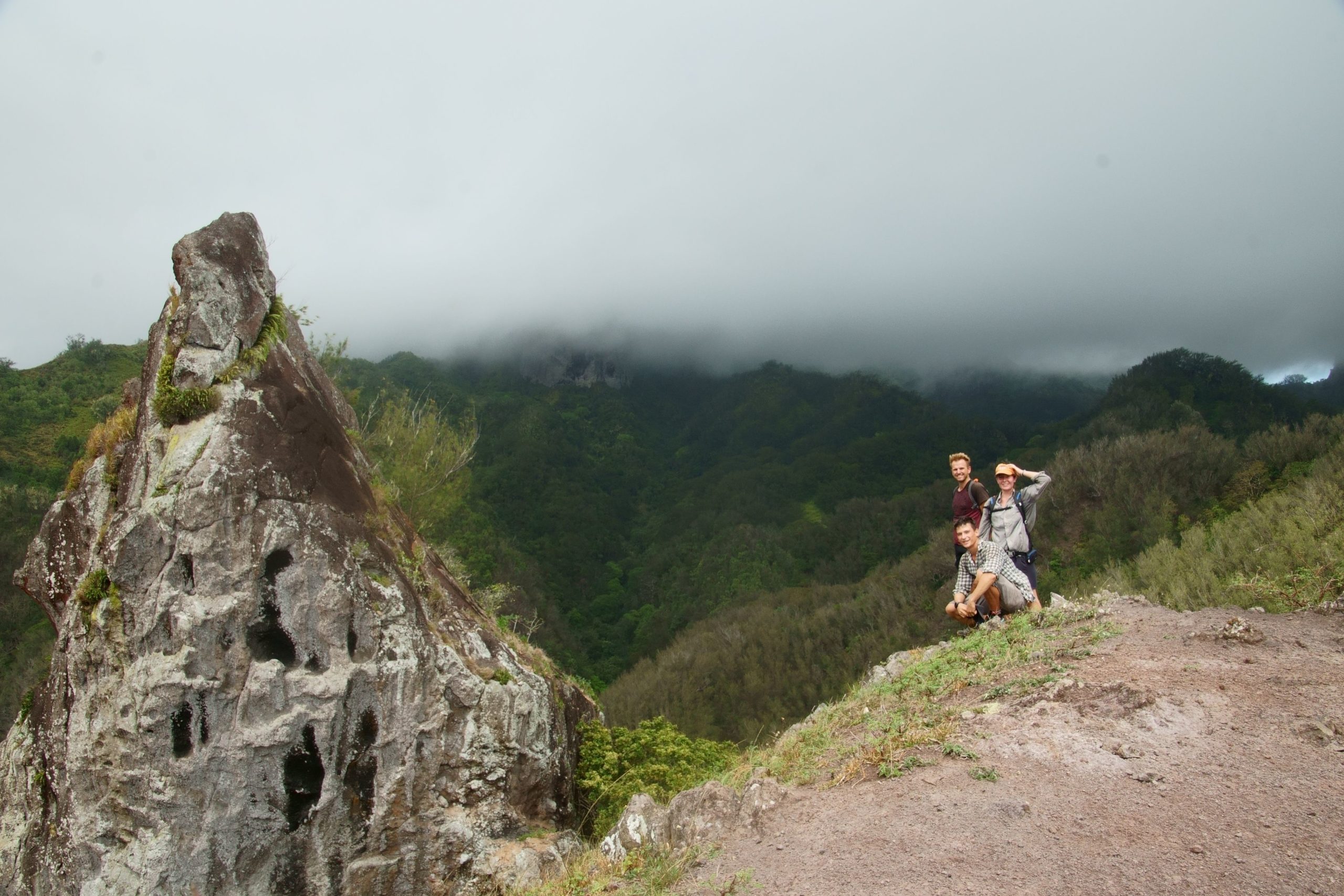
From Ua Pou we went back to Nuku Hiva once again. Here we replenished our supplies of fresh fruit, vegetables and water and prepared for the crossing to Makemo, an atoll in the Tuamotus.
Small dictionary for sailing in the Tuamotus:
- Tuamotus: group of islands in French Polynesia; on the way between the Marquesas Islands and Tahiti and Moorea(Society Islands)
- Motu: Another name for a small island on a coral reef – Atoll: A ring of coral reef. Partly with small and larger motus on which isolated people live.
- Pass: Most atolls have a pass, a kind of passage to get into the protected interior of the atoll.
- Slack water: The currents at the passes are enormous due to the tidal differences! It can be up to 20 knots fast in the worst case. Entering and leaving the atoll is usually only possible in slack water (short slack). Slack is when the currents of low tide and high tide alternate and the water stands still for a few minutes
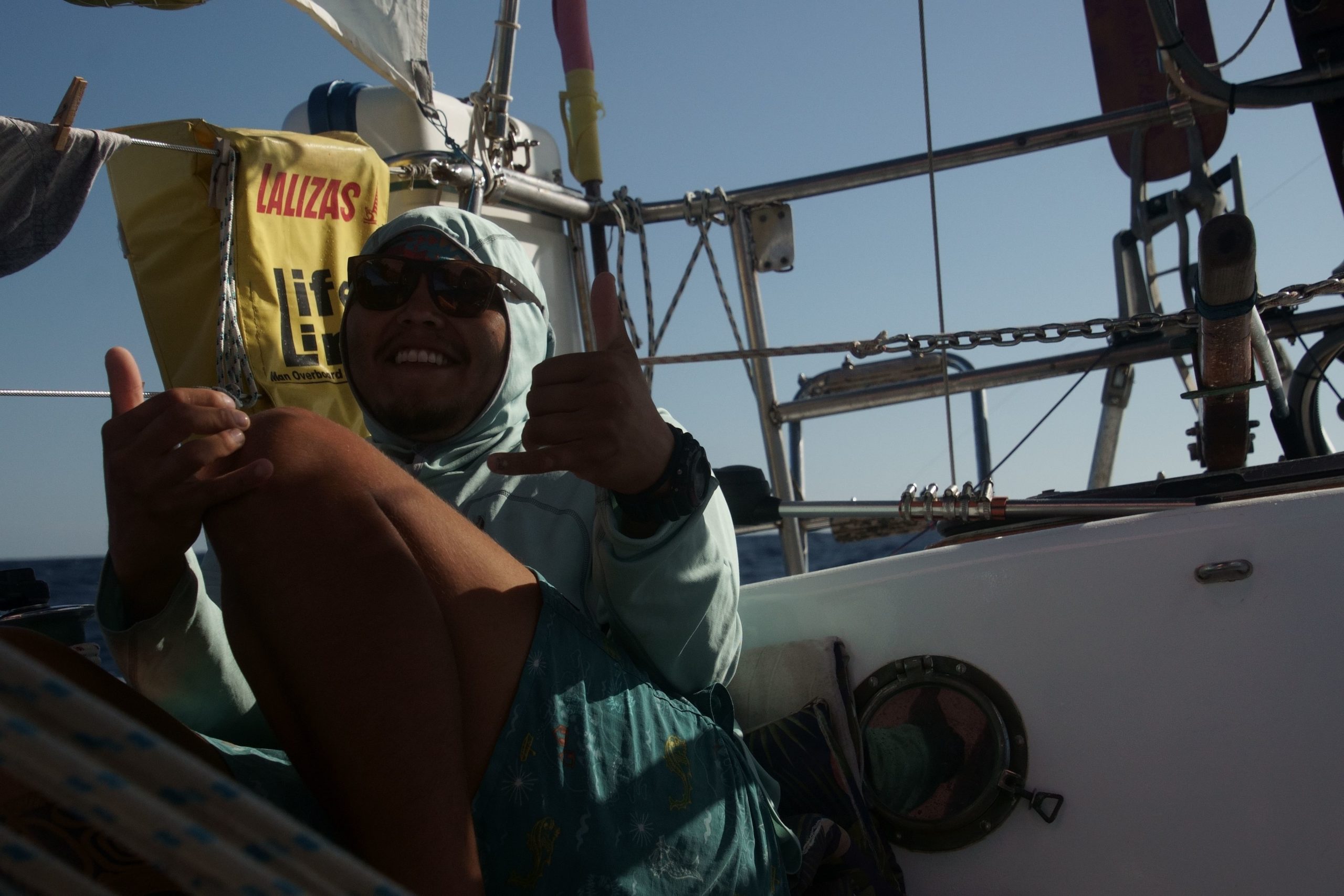
The night before we left, I was chatting with a couple of guys and girls at the Nuku Hiva dinghy dock. We drank a few beers together and I found out that Gabriel („G“), was looking for a ride to Tahiti.
I had been thinking for a while that it would actually be cool to spontaneously take a third person on board with us, and I wanted to try it with G. Emma and I discussed it briefly and agreed to give it a try.
A day later, G came on board. He now sleeps in the saloon; we cleared two compartments for his things and stowed the rest in bags. It fits perfectly! – The 500 nautical miles crossing to the Tuamotus we did the three of us!
In the late afternoon everything was finally stowed and we left the anchorage of Nuku Hiva with direct course to Makemo. The wind was perfect. With 12 knots it blew from SE and hit us almost at right angles. With more than 6 knots boat speed we rushed through the water! We made full speed with full sails! It was a sheer joy!
It’s not that often that you can sail on such a favorable course. For some reason, when sailing, the wind always seems to come either from the front or the back, but never exactly from the side. – And nobody knows why!
The night shifts were also much more relaxed with three of us than with just two! As already on the Pacific crossing, each of us had three hours of watch from sunset and could then go to sleep. Only, this time there were three of us, which meant that after three hours on watch, we could sleep for six hours instead of just three! Pure luxury!

On the morning of the fourth day, I calculated our speed and our distance to the finish. We still had 130 nautical miles ahead of us and would have to make it to the pass by 15:30 in the afternoon of the next day to be able to cross the pass during slack tide. With our current boat speed, about 5 knots we would have arrived one to one and a half hours late. It would have been dark and we would have had the full current against us.
We had no choice but to reef the sails and reduce our speed to the point where the wind vane could just hold course. We had to wait for the slacktide the next day.
With two and a half knots we bobbed over the ocean from now on. Boring; rocky; and above all: slow! – At least, as a small compensation we organized a great movie night with good Jason Statham action, popcorn and candy!
We reached Makemo the next morning at just the right time. It was exciting: Our first reef passage into an atoll! Another sailboat had lined up behind us. We set full sail and managed to sail high up the wind through the pass (the engine was on for safety). We turned right and dropped anchor just before the village.
“We made it!”. Around us turquoise water; on the shore palm trees and sandy beach. A new paradise to explore!


